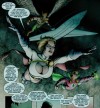The Dark Knight is the sequel to 2005’s Batman Begins, which I enjoyed quite a bit. Remember when Batman came out in 1989 and everyone was wondering whether it would be a campy film like the 60s TV series which had influenced 1978’s Superman to its detriment? Fans lauded Tim Burton’s take on the caped crusader for being dark and serious.
Well, Burton ain’t got nuthin’ on Christopher Nolan, director of the current franchise.
Here, Batman (Christian Bale) and squeaky-clean district attorney Harvey Dent (Aaron Eckhart) are on the verge of shutting down Gotham’s crime families, especially after Batman manages to haul in the crime lords’ “accountant” from Hong Kong. The crime lords get into bed with the maniacal Joker (Heath Ledger) to take out Batman, and the Joker sets out to do in all the big names who are maintaining law and order in Gotham, showing himself capable of intricate, seemingly-impossible crimes of murder and mass destruction.
Batman’s alter ego, Bruce Wayne, has high hopes that Dent can be the hero Gotham need and that he can put aside his double identity and marry his childhood sweetheart, Rachel Dawes (Maggie Gyllenhaal). But, unable to wait for Bruce forever, Rachel is not only working with Harvey in his office, but dating his publicly. Which, of course, also puts her in the line of fire of the mob and the Joker.
The Dark Knight is a very dark film indeed, even though much of it takes place in the daytime: Harvey, Rachel, Lieutenant Gordon (Gary Oldman), the commissioner, the mayor, all the good guys are constantly under siege by people who vanish in the shadows after striking. The Gotham police department is deeply corrupt, which bothers Dent to no end even though he knows that dirty cops are better than the only alternative, which is no cops at all. It makes the film feel constantly suspenseful, even in the daylight scenes, even in places we expect will be safe for the heroes. Only his secret identity gives Batman himself any safety. (Although one does wonder why Bruce Wayne isn’t a high-profile target for the criminals of Gotham.)
Ledger is quite good as the Joker. Jack Nicholson’s performance in the 1989 film also drew kudos, but I always thought he was just playing ‘nutty old Jack Nicholson’, and I thought his performance was a low point of that film. Ledger is dark and menacing and convincing in being “crazy like a fox”, the sort of crazy where he’s willing to do anything to get what he wants, and where his appearance makes others underestimate him, often for the last time. Is his performance worthy of an Oscar, as has been suggested? I didn’t think so, but he did do a good job.
The film is a fine suspense and action-adventure piece. What makes it really work is that there’s some real characterization behind the cape: Bruce isn’t as meaty a character here as he was in Batman Begins, but Harvey, Rachel and Lt. Gordon all pick up the slack and contribute to giving the film more heft than just a lot of chasing and fighting and lunacy, it gives the characters something to fight for.
Despite that, the film does have its flaws. First, it’s overlong, with perhaps one too many clever plans of the Joker’s that Batman has to stop, and one too many nifty gimmicks that Batman can employ – his little trick with Lucius Fox’s (Morgan Freeman) latest technological innovation was cool, but implausible and unnecessary. Second, while the resolution of the Bruce-Harvey-Rachel triangle works for the film (though it’s not a happy ending), the Batman-Harvey-Joker triangle ends rather anticlimactically, separating the Joker and Harvey into two separate threads when it would have been far more satisfying to have them all merge together in the final fight against the Joker. While the Joker’s character is rife with meaning, I thought Nolan missed a chance to imbue Harvey Dent’s fate with the same degree of meaning – or at least a demonstration that even the Joker should sometimes be careful what he wishes for.
Still, The Dark Knight is quite a good film, stylish and intense. Definitely not a kids’ film, as there are some pretty brutal scenes. But maybe the most serious superhero film ever made. Which shows how far we’ve come in 40 years.
A few more, spoiler-laden comments after the cut:
Continue reading “The Dark Knight”































